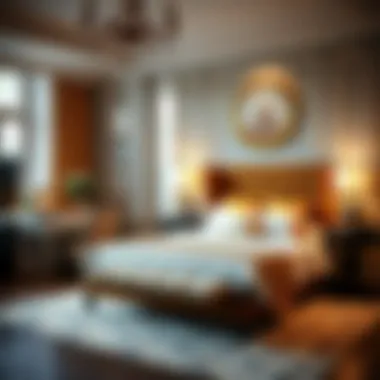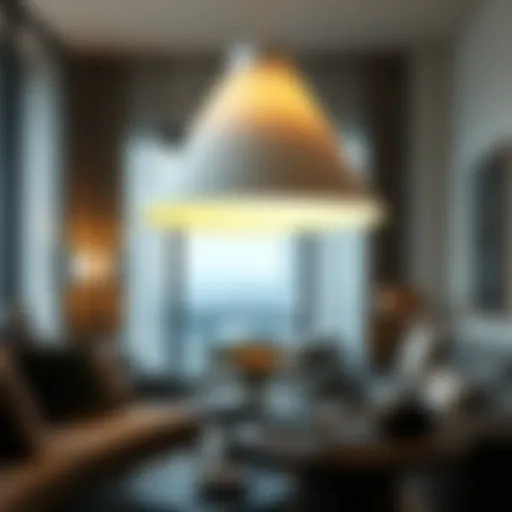Harmonizing Your Space: The Art of Matching Beds and Desks


Intro
Creating a harmonious living or working environment is a balancing act that many often try to master. A significant part of this balance involves aligning the aesthetic and practical aspects of furniture pieces within a space. Specifically, it's essential to consider how beds and desks complement each other. When one can seamlessly integrate these functional elements, it’s not just about style; it’s about fostering a sense of tranquility while being productive. Hence, how we approach the matching of beds and desks becomes a vital conversation in design.
Furniture doesn't just fill up space; it shapes our mood, productivity, and even our relationships. Whether you are a homeowner seeking comfort or a designer in pursuit of trends, understanding how to harmonize these two pivotal elements of your interior is essential. Let’s dive into the latest design currents that guide our choices when it comes to beds and desks.
Design Trends
Current Trends in Furniture Styles
Furniture design is ever-evolving, reflecting societal shifts and lifestyle changes. Recent trends highlight an inclination toward minimalism, natural materials, and multifunctional pieces. This shift is not merely an aesthetic choice; it connects deeply with our desire for simplicity and utility in our bustling lives.
- Scandinavian Influence: This style boasts clean lines and light colors, merging functionality and beauty. Think about light woods paired with soft fabrics, ideal for both beds and desks.
- Industrial Chic: Exposing textures, such as raw wood and metal, creates a rugged yet refined look. This perfect blend of elegance and grit can transform a bedroom or an office into an inspiring sanctuary.
- Sustainable Design: As people become more aware of their ecological footprint, choosing eco-friendly materials becomes a pressing trend. Bamboo beds and desks made from recycled wood are staples in many stylish homes.
The design ethos today often prioritizes pieces that enhance rather than clutter a space.
How to Incorporate Trends into Your Space
Translating these trends into your home or workspace means thoughtful consideration of your needs and surroundings. It’s not about following trends blindly; rather, it’s about selecting pieces that resonate with your personal aesthetic while also creating a cohesive environment. Here are some strategies:
- Scale and Proportion: Ensure that your bed and desk are in a similar scale; oversized furniture can overwhelm small spaces, while small pieces may look lost in expansive areas.
- Color Coordination: Establish a color palette that flows seamlessly between both furniture pieces. Neutral tones can provide versatility while pops of color from accessories can draw attention where needed.
- Material Matching: While it’s not necessary to have every piece match precisely, using similar materials can unify the look. For instance, a wooden desk paired with a bed frame of the same wood type creates a harmonious feel.
"Great design is not just about aesthetics; it's a reflection of who we are and how we wish to experience our spaces."
Buying Guides
Choosing the Right Furniture for Different Rooms
Selecting the right furniture often depends on the function of the room. A bedroom and a workspace serve different purposes, hence their contents should reflect that. For bedrooms, comfort is key; think about mattresses and bedding that promote restful sleep. In contrast, a desk should prioritize ergonomics to support long hours of work.
- For Bedrooms: Look for beds that encourage relaxation, such as plush upholstered ones or sleek wooden frames, creating a cozy haven.
- For Workspaces: Focus on desks that offer storage and organizational features without being overly bulky.
Tips for Assessing Quality and Value
When it comes to furniture, investing in quality often pays off in the long run. To assess the quality of beds and desks:
- Materials: Look for solid woods over particle boards. Sturdiness goes a long way.
- Finishing Touches: Check for smooth surfaces and well-connected parts; poor construction can lead to future headaches.
- Functionality: A good desk should accommodate your needs and lifestyle. Examine drawer space and cable management systems, especially in an age dominated by technology.
By being mindful of these details, incorporating beds and desks into a unified and aesthetically pleasing design can enhance the ambiance of any home or workspace. As we continue, we will analyze personal style preferences and how they can elevate the overall design experience.
Prelude to Matching Furniture
Creating a harmonious environment, whether at home or in a workspace, frequently hinges on more than just functionality; it is about aesthetics and how elements blend together within the space. When talking about matching furniture, particularly beds and desks, there is an unspoken recipe of design elements intertwining not only in looks but in feel, color, and practicality. Cohesion in furniture design enables one to nurture an atmosphere of peace, focus, or creativity, depending on the personal goals of the space.
The Importance of Cohesion in Design
Cohesion in design plays a paramount role in the overall success of a room's aesthetic. Think of it as the glue that holds the ensemble together. When bedding and desks complement each other in style and color, it creates a seamless flow in the room. A stark mismatch can feel jarring, almost chaotic, and can draw attention away from the individual enjoyment and utilization of each piece.
For example, imagine a sleek, modern desk made of polished metal and glass sitting next to a heavy, rustic wooden bed. While both pieces may be stunning, they might feel out of place when they come together in the same setting. Cohesion fosters a sense of tranquility and focus, which is especially crucial when designing a workspace that encourages productivity. By ensuring each piece relates to the others through similar themes or colors, one encourages an environment where creativity can thrive.
Assessing the balance between practicality and aesthetics is also part of achieving design cohesion. You can select a minimalist desk that doubles as a bed stand, harmonizing both function and visual appeal. This kind of strategic thinking not only elevates the space but also ensures efficient use of resources, creating spaces that feel bigger than they are and reducing clutter visually and physically.
Defining Individual Preferences
Defining individual preferences in matching furniture involves understanding what shapes an individual's tastes and needs. Each person has distinct likes, dislikes, and styles that resonate with them. Some might prefer bold, brighter hues that inspire energy, while others are inclined towards muted tones promoting serenity. Whether it’s a love for vintage aesthetics or modern minimalism, individual preferences outperform any rigid design rules.
To determine personal style, taking a cue from existing décor can be incredibly insightful. For instance, if the bed boasts a deep navy blue headboard, one might consider a desk that shares this color in its finish or accents. Similarly, textures play a key role; pairing a plush upholstered bed with a sleek, streamlined desk can create an intriguing contrast while remaining cohesive.
Moreover, the functionality of both pieces ties back to personal preference. Some need spacious desks for multiple monitors and paperwork, whilst others might prioritize compact styles. It’s about finding a balance between what looks appealing and what makes sense in day-to-day use.
By engaging in this reflective process, designers and homeowners alike can avoid the pitfalls of trends and create a space tailored specifically to their needs. When it comes to harmonizing environments, understanding personal preference is not merely a step in the design process; it’s at the very heart of successful furniture matching.
Understanding Bed and Desk Dynamics
When it comes to creating a balanced and harmonious living or working space, understanding the relationship between beds and desks is crucial. While they serve different purposes, these pieces of furniture can complement each other in ways that enhance both functionality and aesthetic appeal. The goal is to create a space that is not only practical but also inviting, showcasing a cohesive design that speaks to your personal style.


Matching beds and desks goes beyond mere appearances; it involves recognizing the interaction of elements in a room. This interaction can transform an ordinary space into an extraordinary one, where comfort meets productivity. Often, homeowners face the challenge of integrating diverse furniture styles into a unified look. Therefore, understanding how these two crucial pieces fit together in terms of size, color, and material becomes paramount.
Functional Aspects of Beds and Desks
The functionality of both beds and desks heavily influences their arrangement within any space. A bed is often the centerpiece of a bedroom, while a desk serves as the core of a workspace. When placing them, think of how each piece affects the flow and usability of the room.
- Ergonomics: Both beds and desks should promote a comfortable experience. The height of a desk should accommodate sitting posture, while a bed needs to provide adequate support for rest.
- Utility: Make sure both pieces serve their intended purpose. A desk should be organized and functional, possibly with compartments for files or a space for a computer, whereas the bed should facilitate rest.
- Accessibility: Consider how easily one can access each piece. Clutter or poorly placed items can hinder movement, making a space feel cramped and uninviting.
Spatial Considerations
Spatial considerations are another critical component to keep in mind when harmonizing beds and desks. The overall layout of the room can affect how each piece is perceived and utilized.
- Size and Scale: Ensure that the size of the bed and desk are appropriate for the dimensions of the room. Oversized furniture in a small room can create a sense of claustrophobia, while too-small items can make a space feel empty.
- Proportions: The proportions between the bed and desk should feel balanced. A massive king-sized bed may dwarf a petite desk, leading to visual disarray. Instead, aim for a relationship where both pieces coexist comfortably.
- Room Flow: How you arrange these furniture pieces can dramatically enhance navigational ease. Ideally, paths should remain clear between units, allowing fluidity in movement.
"A well-planned space allows for a blend of functionality and style, whether it's a bustling home office or a cozy bedroom. It's all about connection and flow."
Choosing to harmonize beds and desks is about more than just aesthetics; it’s about crafting a holistic environment that reflects your needs. By controlling the functional and spatial aspects, you lay the groundwork for a cohesive and engaging atmosphere. This understanding is a vital stepping stone as you continue to explore further design principles and popular styles, ensuring that your furniture choices are purposeful and aligned.
Design Principles for Matching Beds and Desks
When setting out to harmonize spaces within a home or workspace, understanding the design principles for matching beds and desks can be a pivotal element. These principles create a foundation that supports both aesthetics and functionality in the environment. The thought that goes into the choice of color, material, and style can significantly influence the overall ambiance of the space.
Color Theory in Furniture Arrangement
Color plays a central role in design, acting as a visual language that conveys emotions and establishes mood. The right color combinations can establish a narrative within a space, linking the bed and desk as more than just furniture pieces, but as parts of a cohesive story.
Considerations for Color Choices:
- Complementary Colors: When selecting colors for your bed and desk, consider using complementary shades that enhance one another. This foster a sense of balance. For instance, a navy blue bed frame paired with a desk featuring warm oak accents can create a serene yet dynamic feel.
- Monochromatic Schemes: Alternatively, monochromatic color schemes subtly unify the room. Using varying shades of the same color, like soft grays with charcoal, lends sophistication without overwhelming the senses, allowing furniture styles to shine through.
- Accent Colors: Don’t shy away from adding splashes of color. Bright cushions on a gray bed or vibrant desk accessories can serve as excellent focal points amidst a more neutral palette, injecting personality into the design.
Material Selection and Harmony
The choice of materials is fundamental in the quest for a harmonious environment. Different materials communicate various feelings and functionalities that can either clash or converge beautifully.
- Natural vs. Synthetic: Natural materials, such as wood, impart warmth and invite a touch of nature into the space. For example, a solid wood desk can complement a plush upholstered bed, creating an inviting atmosphere. On the flip side, sleek metal finishes are typically more modern and can provide a chic look, yet they should be balanced with softer textures to avoid a cold feel.
- Finish Types: The finish of materials is just important. A matte finish can soften the interaction between pieces, while a glossy surface adds contemporary flair. This choice can affect the light dynamics within the room, guiding how the eye moves around the space.
- Durability and Functionality: Ensure that the materials used are durable enough for the room’s purpose. A sturdy desk can withstand day-to-day use, while a plush bed should offer comfort for rest. Consider how materials will interact with daily life.
Style Cohesion: Modern vs. Traditional
Reconciling different styles is crucial for creating a balanced space. Choosing between modern and traditional designs can dictate the overall narrative of the room.
- Modern Styles tend to favor clean lines, minimalism, and functional pieces. A sleek desk paired with a simple platform bed can create a refined, virtually clutter-free aesthetic. Think of materials like brushed steel and glass, which often characterize modern furniture.
- Traditional Styles, in contrast, embrace detailed craftsmanship and rich textures. A classic wooden bed frame can be beautifully contrasted with a refined writing desk adorned with intricate moldings. This interplay between the styles encourages an elegant, timeless quality.
- Mixing Styles can also yield exciting results. A contemporary desk with soft edges might sit comfortably alongside a traditionally styled bed, fostering a dialogue between the old and new, as long as color schemes and materials are harmoniously balanced.
In sum, understanding and applying these design principles can elevate a space on multiple levels. The colors, materials, and styles chosen should resonate with individual preferences while ensuring a balanced environment.
Cohesion in design isn't just about visual appeal; it's about creating functional spaces that reflect personal taste and lifestyle.
For those seeking deeper insights into color theory, materials, or styles, resources like Wikipedia, and Britannica, are excellent for further exploration.
Exploring Popular Matching Styles
When it comes to harmonizing a living or work space, the styles you choose not only affect aesthetics but also functionality. Exploring popular matching styles serves as a guide to understanding how different design philosophies can create a cohesive atmosphere for your bed and desk pairings. This section dives into notable styles that are trending and timeless, helping homeowners and designers alike make informed decisions while also adding a personal touch.
Minimalist Approach
The minimalist approach is akin to the elegance of simplicity. In this design realm, less really is more. Spruce up your space by focusing on clean lines and muted colors. Opt for streamlined furniture that eliminates excess. For example, envision a platform bed with a sleek headboard paired with a desk that shares similar angular qualities – both pieces work together to project an unadorned yet sophisticated vibe.
Benefits of Minimalism:
- Clutter Reduction: A minimal setup naturally promotes order and tranquility.
- Versatile Combinations: Minimalist beds and desks can adapt to various styles, catering to personal tastes.
- Focus on Essentials: It emphasizes functionality without the distractions of ornate designs.
When arranging your furniture, keep the color palette restricted to neutral tones, emphasizing whites, greys, or earthy hues. These colors promote a serene environment, making the space feel larger and more open. Moreover, consider incorporating natural materials like wood or metal to maintain warmth while adhering to a minimalist aesthetic.
Industrial Design Aesthetics
An industrial style may evoke a sense of ruggedness, merging the raw, unfinished charm of warehouse spaces with modern functionality. Think exposed brick, metal accents, and reclaimed wood as staples of this aesthetic. By selecting a reclaimed wood bed and a metallic desk, you can craft an urban sanctuary filled with character.
Key Considerations for the Industrial Style:


- Mixing Materials: Combining metal, wood, and even glass can yield a visually stimulating environment.
- Color Play: Dark hues accompanied by metal elements often set the tone for industrial aesthetics, creating a charmingly moody atmosphere.
- Showcase Elements: Don't shy away from highlighting structural components. Expose some beams and pipes if possible; they add a credible touch.
A successful industrial pairing may include a steel-frame desk that shares similar wooden finishes with your bed. This orchestration not only brings coherence but also sparks conversations through its stylistic choices. An unrefined charm speaks volumes in a modern age preoccupied with perfection.
Bohemian Inspirations
The bohemian style is all about celebrating the unconventional. Rich textures, vibrant colors, and an array of mixed patterns invite warmth and creativity into your space. In a bohemian setup, your bed and desk can become the canvas for self-expression.
Embracing Bohemian Style:
- Layered Textures: Combine quilts, throws, and rugs of varied textiles to establish an inviting atmosphere.
- Vivid Colors and Patterns: Choose bold colors, integrating patterns together to make statements.
- Personal Touches: Highlight personal artifacts and artwork to resonate with your individual journey.
When aligning your bed and desk in a bohemian fashion, try using a wooden bed frame adorned with bright throws paired with a unique, vintage-style desk sprinkled with trinkets. Drape a colorful tapestry behind the desk as a backdrop, creating a focal point that enhances the whole room's character. The result? A lively atmosphere that reflects deeper stories.
Explore various design styles to realize the harmony between your bed and desk. Choosing corresponding aesthetics can amplify the ambiance while reflecting your personality.
In essence, knowing these popular styles equips you with the knowledge to make strategic decisions. From the sleek simplicity of minimalism to the raw appeal of industrial and the vibrant expressiveness of bohemian designs, these styles offer rich avenues for exploration. Ultimately, the choice of matching beds and desks should not only be about appearance but also about cultivating a space where you feel at home.
Practical Tips for Implementation
When it comes to crafting a living or working space, matching beds and desks is a journey that deserves thoughtful planning. Practical tips for implementation serve as a guiding compass, offering strategies that can turn your space from mundane into something harmonious and functional. Such strategies not only enhance aesthetics but ensure that each piece of furniture works well together, promoting ease of use and a sense of tranquility. Here are several key areas to focus on for successful implementation.
Choosing the Right Size
Selecting the right size for your bed and desk is crucial. The dimensions must cater to the needs of the space while allowing ample room for movement. For example, if your desk is too large for the area, it can overpower the bed, creating a disjointed feel. On the flip side, a bed that’s too small might leave the space looking empty or ill-equipped.
Here are a few considerations:
- Measure Your Space: Before making any purchases, measure the room. Ensure ample clearance around both pieces. A safe bet is to leave about two feet on either side of the bed for easy access.
- Proportion Matters: When pairing a desk with a bed, think about how the two will visually interact. A low-profile bed might pair well with a taller desk, creating an intentional contrast.
- Functional Needs: Consider what you'll be doing at your desk. If it's for work, ergonomics come into play; a desk at the right height affects your posture. If it's meant for leisure, adjust according to comfort, possibly choosing a set-up that promotes relaxation.
Arranging Your Space Effectively
Once you have the right sizes picked out, arrangement becomes key to optimizing your space. In small areas, it might be tempting to line everything against the walls, but this can create a cramped vibe. Creating a flow throughout the room encourages a sense of openness.
You might consider:
- Zoning: Designate areas for different activities. For instance, keep your bed as a serene sleeping zone, while the desk serves as a functional workspace. A well-defined layout can enhance productivity.
- Balance: Strive for visual balance. If you have a solid bed frame, a more delicate desk design can soften the view. Conversely, if the desk is massive, consider a bed with a pared-back aesthetic.
- Focal Point: Decide which piece you want to emphasize. If it’s the bed, arrange the desk to lead the eye towards it by placing lighting options that draw attention subtly.
Utilizing Space-Saving Solutions
In many cases, especially in urban settings, space can be limited. However, there are numerous ways to make your bed and desk coexist without feeling crowded.
Here are a few clever space-saving solutions:
- Multi-functional Furniture: Look for pieces that serve multiple purposes; consider a bed with built-in drawers or a desk that folds away. These designs can be lifesavers for those who need to maximize every square inch.
- Vertical Space: Don’t forget about the walls. Utilize shelves above the desk for books or decorative items, which can free up the desk surface for other tasks.
- Under-Bed Storage: Consider containers that fit under the bed to store items not used daily. This keeps your space tidy while ensuring everything has a place.
A harmonious space is not merely about aesthetics; it combines functionality, practicality, and vision.
By implementing these practical tips, you can create a seamlessly styled area that feels cohesive. Each choice you make—from size and arrangement to space-saving strategies—plays a vital role in driving the overall effect of your environment.
Case Studies: Successful Combinations
Exploring case studies that highlight successful combinations of beds and desks is critical in illustrating how homeowners can harmonize spaces effectively. These real-world examples provide insights into practical applications of design principles discussed earlier. They not only showcase aesthetic appeal but also underline the functional benefits of well-coordinated furniture arrangements. Moreover, examining these cases reveals how diverse personal styles can still maintain coherence through careful selections and arrangements.
Urban Studio Approaches
In urban settings, where space is often limited, maximizing functionality becomes paramount. One notable example is a compact studio apartment in New York City. Here, the residents chose a queen-sized bed with built-in storage beneath it, paired with a sleek, wall-mounted desk that folds down when needed. This arrangement allowed for an open floor plan during the day, transforming the space from a bedroom to an office seamlessly. The neutral palette of whites and grays used in both furniture pieces created a light, airy atmosphere, making the space feel larger than it is.
Another case worth mentioning is an industrial-style loft, where a reclaimed wood bed frame and a metal desk complemented each other beautifully. The rugged textures of the bed contrast with the smooth, polished surface of the desk, providing a balanced aesthetic. A few carefully chosen accessories, like a vintage lamp and abstract art, further enhanced the industrial vibe without overcrowding the space.
These examples emphasize that when working with limited space, every piece should be multifunctional and visually complementary, considering both form and function.
Family Room Coordination
In family spaces, the challenge often lies in balancing aesthetics with durability and ease of use. A perfect case study to illustrate this is a family room designed with a robust wooden bed and a sturdy desk made of the same material. Here, both pieces share a rich walnut finish that not only promotes visual continuity but also withstands the wear and tear from daily activities.


In another family-oriented setup, we can see a playful approach where a lofted bed allows for an expansive workspace beneath. The desk in this setup showcases bright, inviting colors, which contrast with the more subdued tones of the bed. This arrangement not only maximizes space but also invites creativity, especially in a room shared by siblings.
It’s imperative to consider the functional needs and styles of all family members when harmonizing beds and desks in communal areas like family rooms. Children might benefit from vibrant colors and adaptable designs, while adults may prefer more sophisticated hues and materials. Striking the right balance fosters an environment that caters to diverse needs while maintaining coherent design.
The right combinations of colors, materials, and styles can elevate any space, making it both functional and visually pleasing.
Ultimately, these case studies provide a wealth of inspiration and practical ideas for homeowners looking to harmonize their living spaces. They highlight the importance of understanding the dynamics of both beds and desks, ensuring that each piece serves a purpose while contributing to a cohesive atmosphere.
Accessories and Additional Elements
When it comes to crafting a harmonious environment between beds and desks, accessories play a pivotal role. These elements not only bridge the visual gap between different pieces of furniture, but they also enhance functionality and comfort. A thoughtfully curated selection of accessories can tie a room together, creating a cohesive atmosphere that reflects personal taste and style.
The integration of accessories can usher in a world of benefits, such as:
- Personalization: Accessories allow you to showcase your personality. It's in the small details – the artwork on the wall or the throw pillows on your bed – that your space truly comes alive.
- Functionality: Practical items like organizers or desk lamps can improve usability while also serving as stylish decor.
- Cohesion: Carefully selected accessories can unify disparate furniture pieces, making them feel like they belong in the same space.
However, it's not just about slapping a few trinkets on your desk or hanging art above your bed. Here are a few considerations that homeowners, designers, and enthusiasts should keep in mind when incorporating accessories into their setups:
- Color Coordination: The color scheme of your accessories should complement the colors of your bed and desk. For example, a warm-toned bedspread pairs beautifully with a cool-toned desk decor if chosen wisely.
- Scale and Proportion: Think about how the size of the accessories relates to the furniture. A massive piece of art can dominate a small room while tiny ornaments might get lost in a large space.
- Theme Consistency: Whether you've chosen minimalist, industrial, or bohemian styles, your accessories should echo that theme to maintain harmony.
Incorporating Art and Decor
Art and decor offer a unique opportunity for expression in spaces where beds and desks coexist. Framed photographs, painting, or even wall hangings can serve as focal points. Here’s how to do it right:
- Select Pieces that Speak to You: Choose artworks that resonate with your emotions. If landscapes inspire you, a vibrant nature print could serve both as decor and a source of motivation.
- Placement Matters: Position art at eye level where it can be appreciated without being overshadowed by furniture.
- Mix Textures: Balance sleek desks with softer art mediums like fabric or canvas to create contrast.
Lighting Considerations
Lighting is more than just a functional necessity; it sets the mood and tone of your space. It's crucial in ensuring the areas around your bed and desk are well lit and inviting. Here are some ideas to elevate your lighting game:
- Layered Lighting: Consider using multiple light sources such as desk lamps, overhead lights, and even decorative string lights. This creates depth and dimension in your space.
- Adjustable Features: Invest in lamps with adjustable brightness. This allows you to transition from a bright work mode to a relaxed ambiance for unwinding at night.
- Focus on Design: Choose lighting fixtures that fit your overall style. An antique lamp might serve well in a traditional setting, whereas a sleek, modern pendant may fit better in a minimalist area.
"Attention to detail is what drives peace and beauty in any decor."
By minding these aspects, anyone can create a visually appealing space that remains practical, reflecting both personality and purpose.
Maintaining Balance and Functionality
When it comes to creating a harmonious living or working space, the intersection of balance and functionality holds critical importance. Ensuring that each piece of furniture complements both aesthetic desires and practical needs is a challenge that many face. The relationship between beds and desks is especially significant due to their prominent roles in both home and office environments. Achieving equilibrium between these two elements can lead to an enhanced ambiance as well as improved usability.
Evaluating Ergonomics
Understanding ergonomics is essential when coupling beds with desks. Each piece must serve its purpose without compromising comfort or health. For example, a desk should be at a height that promotes good posture, allowing you to work for extended periods without fatigue. Similarly, the height of the bed can influence how one transitions from sleep to work, particularly in smaller spaces where each movement counts. A few key considerations are:
- Desk Height: Ensure that the desk is at an appropriate level for typing and writing, preferably 28 to 30 inches from the floor for most users.
- Chair Comfort: Pair a good-quality chair with wheels if mobility is required. The design should support lower back and lumbar comfort.
- Bed Height: A bed that is either too high or too low can make it difficult to get in and out comfortably, impacting daily routines.
By attending to the ergonomics of the bed and desk, one creates a synergy that not only elevates their design aesthetic but also their functional integrity.
Ensuring Ease of Use
Ease of use refers not just to the physical comfort while using these pieces, but also to their integration within the room. How easily can you transition from one piece of furniture to another? This aspect is essential in spaces where productivity is key.
- Accessibility: Both beds and desks should be positioned to allow natural flow within the room. A desk too close to the bed can create a cramped atmosphere, limiting movement.
- Storage Solutions: Implementing storage under the bed or utilizing multi-functional furniture can ease clutter and make the space feel organized, ensuring that items are within easy reach when needed.
- Arrangement Considerations: Consider the direction of light and view when placing your desk and bed. This can greatly affect not only functionality but also mood.
In summary, maintaining balance and functionality is at the core of creating a successful environment with paired furniture. By critically evaluating ergonomics and ensuring ease of use, homeowners, designers, and enthusiasts alike can create a space that resonates with both comfort and visual appeal. When the right elements come together, the space not only functions well but ultimately feels welcoming and complete.
Concluding Thoughts on Harmonizing Function and Aesthetics
Finding a balance between function and aesthetics is essential in creating harmonious spaces. This article has delved into the intricacies of matching beds and desks, underscoring how these two pivotal furniture pieces can and should complement each other. The layout, style, and utility of a room rely heavily on the thoughtful integration of furniture. Therefore, understanding the weight of this relationship isn’t just beneficial—it’s crucial for homeowners, designers, and even retailers.
The significance of harmonizing function and aesthetics comes down to more than just visual appeal. When a workspace operates efficiently, contributing to productivity, the aesthetic aspect enhances the atmosphere, leading to better moods and creativity. On the flip side, spaces that prioritize one element at the expense of the other often create a discord that leaves inhabitants feeling unsettled or frustrated.
Importance of Cohesion
Cohesion in design cultivates a sense of peace and order in our surroundings. When beds and desks are coordinated in terms of style and composition, they create seamless transitions that make a space feel complete. Instead of a mismatched hodgepodge of furniture, well-thought-out combinations invite comfort and functionality.
Benefits to Style and Use
From a more practical standpoint, having matching elements can enhance the usability of a space. It allows for easier navigation, where each furniture piece serves a dual purpose of aesthetic enhancement and functionality. This becomes particularly important in small spaces where maximizing utility is essential—think of transforming a bedroom into a home office without looking cluttered and chaotic.
Considerations for Future Designs
Looking ahead, it is essential to consider new approaches to furniture matching. Trends are evolving towards more sustainable materials, multi-functional designs, and personalization options that cater to individual needs. As the furniture industry aims for greater environmental consciousness, matching beds and desks with elements made from recycled materials could become a significant focus.















